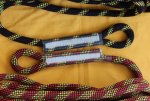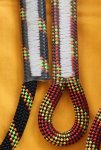Gsailor
...
Being interested I researched (Googled) and found a lot of videos.
I have not watched them yet.
I am intrigued to find out where the needle goes in 12 strand piece of rope that is known for being slippery.
how to stitch dyneema slicrs - Google Search
I have not watched them yet.
I am intrigued to find out where the needle goes in 12 strand piece of rope that is known for being slippery.
how to stitch dyneema slicrs - Google Search


